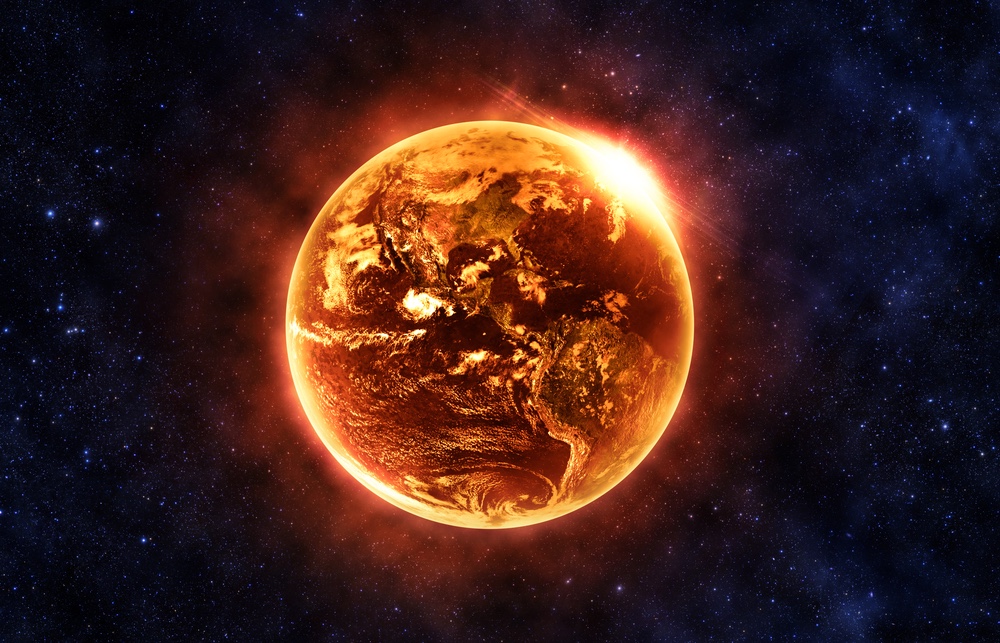
Earth could turn into a hothouse planet like Venus, with boiling oceans and acid rain, if humans don't curb irreversible climate change, physicist Stephen Hawking claimed in a recent interview.
"We are close to the tipping point, where global warming becomes irreversible. Trump's action could push the Earth over the brink, to become like Venus, with a temperature of 250 degrees [Celsius], and raining sulfuric acid," he told BBC News, referring to the president's decision to pull the U.S. out of the Paris climate deal.
But most climate experts say that scenario is a dramatic and implausible exaggeration: Relative to Venus, planet Earth is much farther from the sun and given its chemical makeup will never have such a thick carbon dioxide atmosphere, so it could not likely reach temperatures of 482 degrees Fahrenheit (250 degrees C) that Hawking described in the interview, they say. [Doomsday: 9 Real Ways the Earth Could End]
However, the general trend of runaway and catastrophic climate change is a real concern, experts said.
"Hawking is taking some rhetorical license here," Michael Mann, a climate scientist at the Pennsylvania State University, told Live Science in an email. "Earth is further away from the sun than Venus and likely cannot experience a runaway greenhouse effect in the same sense as Venus — i.e. a literal boiling away of the oceans. However Hawking's larger point — that we could render the planet largely uninhabitable for human civilization if we do not act to avert dangerous climate change — is certainly valid."
Hothouse planet
Venus is the second planet from the sun and the brightest planet in the solar system; though the planet is named after the Roman goddess of love and desire, don't expect to take a trip to the balmy planet with your sweetheart anytime soon. Despite being the same size as Earth and having roughly the same gravity as our home planet, it's a far cry from our water-drenched planet. Venus is the hottest planet in the solar system, with temperatures reaching 870 degrees F (466 degrees C). The reason for these sweltering temperatures is Venus' thick carbon-dioxide atmosphere that is dotted with sulfuric acid clouds; the atmosphere traps much more heat than our own does. It is also much closer to the sun, meaning it absorbs much more solar radiation than Earth. Churning volcanoes add to Venus' reputation as an inferno. [7 of the Hottest Places on Earth]
The leading theory about how Venus came to be such a hellscape is that the planet got caught in a feedback loop, wherein the planet absorbed more solar radiation than it released, causing more water vapor to get trapped in its atmosphere. That, in turn, led to greater heat absorption, and runaway warming (also called a runaway greenhouse effect).
Get the Space.com Newsletter
Breaking space news, the latest updates on rocket launches, skywatching events and more!
"Basically, Venus was in a state of heat stroke — the planet was in a warming state and it couldn't cool down," said Tyler Robinson, an astrobiologist at the University of Washington.
Unlikely on Earth
Though most humans take for granted the relative constancy of an Earth-like climate, our planet has undergone dramatic changes in its 4.5-billion-year history. During the Great Oxygenation Event, around 2.5 billion years ago, photosynthetic cyanobacteria fueled a huge rise in oxygen in the atmosphere. Around 650 million years ago, the entire planet froze, in a phenomenon known as "snowball Earth." And during the dinosaur age, the planet was, on average 18 degrees F (10 degrees C) hotter than it is now, with a carbon dioxide-rich atmosphere. And huge "carbon excursions" have led to massive extinctions in the past — such as the end-Permian extinction around 252 million years ago, when roughly 95 percent of sea life died out due to ocean acidification. [Photo Timeline: How the Earth Formed]
So it's not unreasonable to contemplate the possibility of a runaway climate scenario, Robinson said. Still, most experts, including Robinson, see that possibility as incredibly unlikely.
While in theory, a process similar to the one experienced on Venus could take place on Earth, the process would most likely occur over hundreds of millions of years, most experts believe, Robinson said. There are also very low odds that Earth's oceans could literally boil away like Venus' primeval oceans did, Robinson said.
Earth, meanwhile, is protected from solar radiation by an atmosphere that is dramatically different from that of Venus.
"Venus' atmosphere is about 100 times thicker than Earth's atmosphere, and composed almost entirely of CO2 [carbon dioxide]," Robinson said. By contrast, Earth's atmosphere is mostly molecular nitrogen and oxygen, with less than 0.04 percent coming from carbon dioxide, Robinson told Live Science in an email. [Infographic: Earth's Atmosphere from Top to Bottom]
Without a thick carbon dioxide atmosphere and the extra dose of solar radiation from the sun, only willful malice is likely to cause a runaway greenhouse scenario, said Kevin Zahnle, a space scientist at NASA Ames Research Center, who has analyzed runaway greenhouse projections for the planet.
"There is no rational expectation of a runaway [greenhouse effect] in the facts as we know them," Zahnle told Live Science in an email.
For one, there were much warmer climates on Earth in the relatively recent past, such as during the Eocene epoch (between 56 million and 34 million years ago), and no signs of a runaway greenhouse effect, Zahnle said. At that time, CO2 levels were likely three times higher than they are now. Even imagining a future with cars, planes and air conditioning on full blast, no climate projections predict such high levels of CO2 in our atmosphere, he said.
"A runaway greenhouse effect is not in the cards," added Kevin Trenberth, a climate scientist at the National Center for Atmospheric Research in Boulder, Colorado.
Of course, there is always the possibility of deliberate sabotage, Zahnle said.
"Dr. Evil might consider an engineering solution akin to the engineering solutions proposed to terraform Mars, but the scale of the effort would be stupendous," Zahnle said. "You'd need fluorocarbons — so Dr. Evil would need to create a worldwide religion dedicated to the sacred use of hairspray and underarm deodorants," Zahnle said. (In the past, some consumer aerosol products contained fluorocarbons, though the U.S. has banned the ingredients in the late 1970s.)
Climate catastrophe possible
Nontheless, Earth doesn't have to become like Venus for life on Earth to become hellish.
The Paris Agreement aimed to keep warming below 3.6 degrees F (2 degrees C) compared with preindustrial temperatures, but even reaching that level for sustained periods could cause changes that are already underway to completely disrupt ecosystems and farming, Trenberth told Live Science. [Trump Pulls Out of Paris Climate Deal: 5 Likely Effects]
"Trees will still grow but a different species is required. Or farming requires different crops," Trenberth said. "That threatens the water and food supply."
Food and water don't need to vanish, they just need to fall below demand and chaos breaks out, he said. "This sort of thing is increasingly likely after about 2050, as it is likely we will go through 2 degrees Celsius during that decade," Trenberth said.
It is also theoretically possible for CO2 levels to go even higher, Robinson said. If humans were to burn every last bit of fossil fuel on the planet, CO2 levels could rise to almost 10 times their current levels, Robinson said.
"Earth hasn't experienced CO2 levels this high in hundreds of millions of years, and the resulting sea-level change is likely hundreds of feet, so, say 'so long' to all your favorite coastal cities," Robinson said.
Originally published on Live Science.
Join our Space Forums to keep talking space on the latest missions, night sky and more! And if you have a news tip, correction or comment, let us know at: community@space.com.

Tia is the assistant managing editor and was previously a senior writer for Live Science, a Space.com sister site. Her work has appeared in Scientific American, Wired.com and other outlets. She holds a master's degree in bioengineering from the University of Washington, a graduate certificate in science writing from UC Santa Cruz and a bachelor's degree in mechanical engineering from the University of Texas at Austin. Tia was part of a team at the Milwaukee Journal Sentinel that published the Empty Cradles series on preterm births, which won multiple awards, including the 2012 Casey Medal for Meritorious Journalism.










